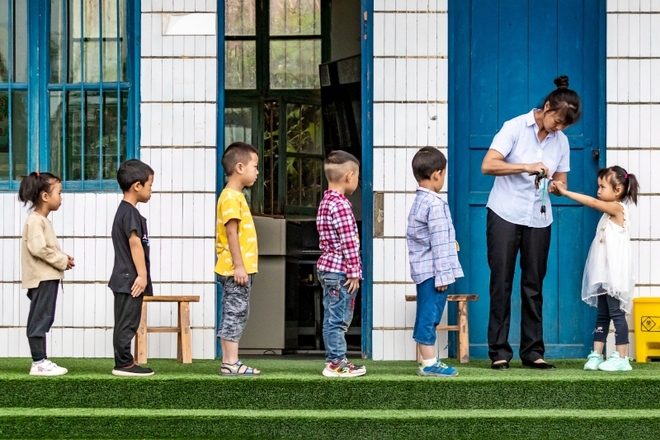[Weekly Preview]In-Depth: The Harsh Reality of the Student Shortage: How Should Education Resources Be Reallocated? (AI Translation)
Listen to the full version


文|财新周刊 黄蕙昭,钟腾达(实习)
By Caixin Weekly's Huang Huizhao, Zhong Tengda (Intern)
高考报名人数连创新高,今年首度突破1300万人大关,但在义务教育阶段,“学生荒”正悄然蔓延。
The number of applicants for the national college entrance examination has continuously hit record highs, surpassing 13 million for the first time this year. However, during the compulsory education stage, a "student shortage" is quietly spreading.
学龄人口的转折来得迅速而猛烈:2023年,许多城市还身处二胎潮带来的小学“最难入学年”,学位预警、超大班额、片区分流现象在各地频现;但从今年起,全国预计有一半以上区县的义务教育学龄人口下降——继幼儿园关停潮后,少子化的冲击已开始向小学、初中蔓延。
The shift in the school-age population has arrived swiftly and forcefully: In 2023, many cities are still grappling with the "hardest year to enroll in primary schools" brought about by the two-child policy wave. Enrollment warnings, oversized classrooms, and zoning adjustments are frequently observed across various regions. However, starting this year, it is anticipated that the school-age population for compulsory education will decline in more than half of the districts and counties nationwide. Following the wave of kindergarten closures, the impact of declining birth rates has begun to extend to primary and middle schools.
“没学生”问题会有多严重?已有研究给出预测:首都经济贸易大学张立龙等研究者基于“七普”(第七次全国人口普查)分析提出,学龄人口规模将在2021—2022年达到峰值约3.28亿人,随后一直下降,在2035年降低至约2.50亿人,减少7800多万人。华东师范大学虞梓钰、胡耀宗预测,即使到2035年以前义务教育体系不再纳入新教师,仅依靠已有教师自然退休,仍有95万小学专任教师、33万初中专任教师过剩。
How severe will the "no students" issue become? Research has already provided predictions: Based on the Seventh National Population Census analysis, researchers such as Zhang Lilong from the Capital University of Economics and Business suggest that the school-age population will peak at approximately 328 million between 2021 and 2022. It will then consistently decline, reaching around 250 million by 2035, a decrease of more than 78 million people. East China Normal University's Yu Ziyu and Hu Yaozong predict that even if no new teachers are added to the compulsory education system before 2035, relying solely on the natural retirement of existing teachers, there will still be a surplus of 950,000 primary school teachers and 330,000 middle school teachers.

- DIGEST HUB
- The number of national college entrance exam applicants in China surpassed 13 million for the first time, while the compulsory education stage faces a student shortage.
- Researchers predict a decline in the school-age population, peaking at 328 million in 2021-2022 and dropping to around 250 million by 2035.
- The decline affects rural and urban areas, causing issues like oversized classrooms, funding challenges, and rising educational costs, necessitating scientific planning and resource allocation adjustments.
The number of applicants for the national college entrance examination in China has continually grown, surpassing 13 million this year. However, a "student shortage" is becoming evident during the compulsory education stage. This paradox stems from swift shifts in the school-age population, attributed mainly to declining birth rates following a temporary rise due to the two-child policy. Although many cities face challenges in enrolling primary school students due to earlier policy effects, a decline in the school-age population for compulsory education is anticipated in over half of the districts and counties nationwide starting this year. Research predicts that the school-age population will fall from its peak of approximately 328 million in 2021-2022 to around 250 million by 2035, a decrease of more than 78 million. This decline could result in a significant surplus of teachers in primary and middle schools by 2035[para. 1][para. 2][para. 3].
Rural areas are particularly affected, with many newly built schools becoming underutilized due to rapid population declines. "Sparrow schools" with very few students are becoming more common. Families often relocate their children to urban schools, facing high educational costs. Urban areas also face strain, although primarily due to concentrated demand in new districts and cities. However, a wave of school closures is expected to spread to urban areas over time. The National Education Work Conference has proposed "forward-looking planning" to address these demographic changes [para. 4][para. 5][para. 6].
Research highlights significant regional disparities in the changes of school-age populations. Central regions with large populations are experiencing the most considerable decline, with large-scale reductions in the number of students expected in provinces like Henan and Hebei. These declines are driven by population outflows and lower fertility rates. Conversely, areas like the eastern coastal regions (Beijing, Shanghai, Guangzhou, Shenzhen, and Hangzhou) are still seeing demand for schooling due to continued population influx. However, even in these areas, there's a shift toward intra-provincial, rather than inter-provincial, migration, changing the school-age population dynamics [para. 7][para. 8][para. 9][para. 10][para. 11].
In regions previously experiencing the most strain, like the Northeast and Central China, significant declines in school populations are underway. For example, primary school student populations in Heilongjiang and Jilin are expected to decrease by 18-20% by 2027. In the central regions, Henan may see a drop of over 20% in primary school enrollments. The trend is similar in provinces like Hunan and Jiangxi, where rural student populations are declining rapidly. However, western provinces like Guangxi and Gansu experience these changes less severely due to their diverse and complex geography and socio-economic conditions[para. 12][para. 13][para. 14][para. 15][para. 16][para. 17][para. 18][para. 19][para. 20][para. 21].
Scientific planning in response to these demographic shifts is crucial. This entails detailed, region-specific analyses based on macro-level data, considering regional and provincial differences. Proper planning can prevent issues like excessive infrastructure and better manage the inflow and outflow of teachers. Field visits and interviews supplement research, providing a granular map of China’s educational demographic changes [para. 22][para. 23][para. 24][para. 25][para. 26][para. 27].
The restructuring of school layouts, required to adapt to these demographic changes, often focuses on closures, mergers, and the construction of boarding schools in townships and county seats to address the declining rural student populations. Rural families continue to push for urban education options, amplified by local governments’ strategies to leverage education to support property markets. However, this leads to concerns about the adequacy of quality education and long-term strain on urban facilities [para. 28][para. 29][para. 30][para. 31][para. 32].
Ultimately, while demographic declines pose significant challenges for educational planning and resource allocation across China's diverse regions, there's an ongoing effort to adjust strategies to maintain quality education standards and respond to shifting populations [para. 33][para. 34][para. 35][para. 36][para. 37][para. 38].
- GALLERY
- PODCAST
- MOST POPULAR





 Sign in with Google
Sign in with Google
 Sign in with Facebook
Sign in with Facebook
 Sign in with 财新
Sign in with 财新